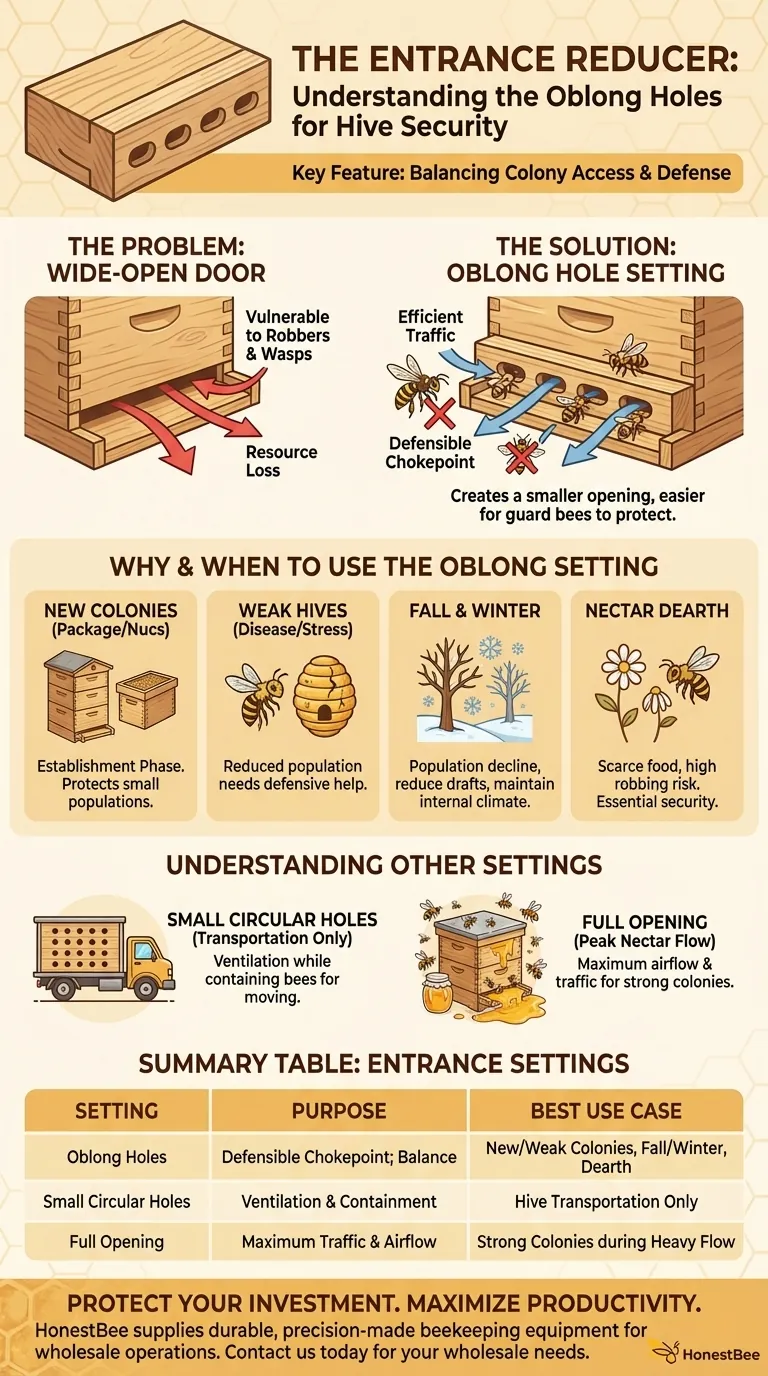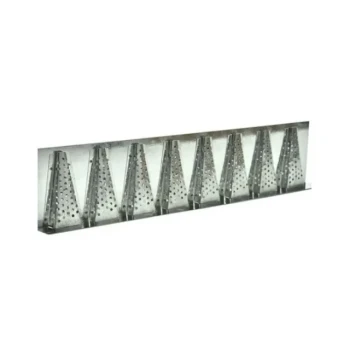The oblong holes on a standard entrance reducer are designed to create a smaller, more defensible opening for the beehive. This feature allows the colony's bees to move in and out efficiently while making it significantly easier for guard bees to protect the hive from invaders like wasps, yellow jackets, or robbing bees from other colonies.
The entrance reducer is a critical management tool, not just a block of wood. The oblong hole setting specifically provides a crucial balance between accessibility for your bees and security for the colony, especially during its most vulnerable periods.

Why Reduce a Hive Entrance?
The Problem with a Wide-Open Door
A hive's large, full-width entrance is designed for maximum traffic during peak season. However, for a new, small, or weakened colony, this large opening is a significant defensive liability.
It creates too much space for the limited number of guard bees to patrol effectively, leaving the colony's precious resources—honey, pollen, and brood—exposed to threats.
Common Threats to a Hive
The primary reason to reduce an entrance is to defend against invaders. Robbing bees from stronger hives can quickly overwhelm a weak colony and steal all its winter stores.
Predators like wasps and yellow jackets also take advantage of poorly defended entrances to prey on bees and steal honey.
Environmental Control
A smaller opening also helps the colony manage its internal environment. During fall and winter, it reduces drafts and helps the bees maintain the ideal temperature and humidity within the hive cluster, conserving energy and food stores.
Understanding the Oblong Hole Setting
The Standard Reduced Entrance
The side with the larger, oblong hole is the most commonly used setting on an entrance reducer. It strikes an essential balance.
The opening is large enough to prevent a "traffic jam" of foraging bees returning with pollen, but it is small enough to be easily guarded. A few dedicated guard bees can effectively defend this single chokepoint.
When to Use the Oblong Holes
This setting is essential in several specific situations:
- New Colonies: Package bees or nucleus colonies (nucs) have small populations and must be protected as they establish themselves.
- Weak Hives: If a hive is struggling due to disease, poor queen performance, or other stressors, its reduced population needs defensive help.
- Fall & Winter: As the colony population naturally declines for winter, the oblong opening provides necessary defense and weather protection.
- During a Nectar Dearth: When natural food sources are scarce, robbing behavior skyrockets. Reducing all hive entrances is a standard management practice during these times.
Understanding the Other Settings
The Small Hole for Ventilation
Most reducers also feature a side with one or two very small, circular holes. This is not for regular entry and exit.
Its purpose is to provide ventilation while keeping the bees contained. This setting is used almost exclusively for safely transporting a hive from one location to another.
The Full, Unrestricted Entrance
Removing the reducer entirely provides the full, open entrance. This should be the default for a strong, populous colony during a heavy nectar flow (typically late spring and summer).
Maximum airflow is needed to help the bees cure honey and to prevent the hive from overheating. A full entrance allows thousands of foragers to work without creating a bottleneck.
The Critical Trade-offs
Security vs. Foraging Efficiency
The core trade-off is between defense and productivity. While a reduced entrance is great for security, it can create a bottleneck for a powerful hive during peak season.
This can limit the amount of nectar the colony can bring in and may contribute to "bearding," where thousands of bees cluster on the outside of the hive to escape internal heat and congestion.
Avoiding Common Mistakes
Leaving the reducer on a strong hive during the summer honey flow can hinder their productivity. Conversely, removing it too early in the spring or leaving it off in the fall can leave a colony vulnerable.
The most critical mistake is forgetting to remove the reducer from the "transport" setting (small hole) after a move, as this will trap the bees inside and prevent them from foraging.
Making the Right Choice for Your Goal
Properly managing the hive entrance is a key indicator of a proactive beekeeper. Use the state of your colony and the time of year as your guide.
- If your primary focus is establishing a new or weak colony: Use the oblong hole setting to give them a defensible entrance from day one.
- If your primary focus is maximizing honey production in a strong hive: Remove the reducer entirely during the main nectar flow to allow for maximum traffic.
- If your primary focus is preparing for fall and winter: Use the oblong hole setting to help the smaller colony cluster defend against robbers and reduce drafts.
- If your primary focus is safely moving your hive: Use the side with the very small hole(s) to secure the bees inside while allowing for essential airflow.
Using the entrance reducer correctly is one of the simplest and most effective ways to support your colony's health and productivity throughout the year.
Summary Table:
| Feature | Purpose | Best Use Case |
|---|---|---|
| Oblong Holes | Creates a defensible chokepoint; balances bee traffic with security. | New/weak colonies, fall/winter, nectar dearth. |
| Small Circular Holes | Provides ventilation while containing bees. | Hive transportation only. |
| Full Opening | Allows maximum foraging traffic and airflow. | Strong colonies during a heavy nectar flow. |
Protect Your Investment and Maximize Hive Productivity
Proper equipment is the foundation of successful beekeeping. Whether you manage a few backyard hives or a large commercial apiary, the right tools make all the difference.
HONESTBEE supplies durable, precision-made beekeeping supplies and equipment—including entrance reducers—to commercial apiaries and beekeeping equipment distributors through our wholesale-focused operations.
Let us help you equip your operation for success. Contact our team today to discuss your wholesale needs and discover how our products can support the health and profitability of your hives.
Visual Guide

Related Products
- Beehive Entrance Reducer Guardian Metal Hive Entrance for Bees
- Multi-Functional Sliding Hive Entrance for Beekeeping
- Steel Round Disc Entrance Reducer for Flexzion Bee Hive Nuc Box Gate
- Multi-Functional Rotary Hive Entrance Disc for Beekeeping
- Beehive Entrance Discs Plastic Bee Entrance Disc for Bee Hives
People Also Ask
- What size is the entrance hole in a native bee hive? The 13mm Standard for a Thriving Colony
- What happens if you seal an entrance to a bee hive? Avoid a Costly Structural Disaster
- What are the different entrance sizes for an 8 or 10-frame Langstroth hive? A Guide to Seasonal Management
- What are the different types of entrance reducers available? A Guide to Protecting Your Hive
- How big should a beehive entrance be? Optimize for Colony Health & Honey Production



















